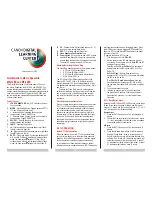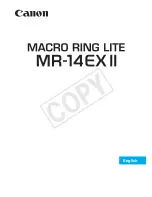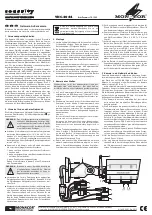
— 60 —
Appendix
1. Precautions
Personnel not trained in dealing with similar electronic devices should not service this camera.
The camera contains components sensitive to electrostatic discharge. The handling of these
devices should follow the requirements of electrostatic sensitive components.
Do not attempt to disassemble this camera.
Do not expose this camera to rain or moisture.
Do not face this camera towards the sun, extreme bright light or light reflecting objects.
When this camera is not in use, put the supplied lens cap on the lens mount.
Handle this camera with the maximum care.
Operate this camera only from the type of power source indicated on the camera.
Power off the camera during any modification such as changes of jumper and switch setting.
2. Typical Sensor Characteristics
The following effects may be observed on the video monitor screen. They do not indicate any fault
of the camera, but are associated with typical sensor characteristics.
V. Aliasing
When the CMOS camera captures stripes, straight lines or similar sharp patterns, jagged edges
may appear on the monitor.
Blemishes
All cameras are shipped without visible image sensor blemishes.
Over time some pixel defects can occur. This does not have a practical effect on the operation
of the camera. These will show up as white spots (blemishes).
Exposure to cosmic rays can cause blemishes to appear on the image sensor. Please take care
to avoid exposure to cosmic rays during transportation and storage. It is recommended using
sea shipment instead of air flight in order to limit the influence of cosmic rays on the camera.
Pixel defects/blemishes also may emerge due to prolonged operation at elevated ambient
temperature, due to high gain setting, or during long time exposure. It is therefore
recommended to operate the camera within its specifications.
Patterned Noise
When the sensor captures a dark object at high temperature or is used for long time
integration, fixed pattern noise may appear on the video monitor screen.
3. Caution when mounting a lens on the camera
When mounting a lens on the camera dust particles in the air may settle on the surface of the lens
or the image sensor of the camera. It is therefore important to keep the protective caps on the
lens and on the camera until the lens is mounted. Point the lens mount of the camera downward
to prevent dust particles from landing on the optical surfaces of the camera. This work should be
done in a dust free environment. Do not touch any of the optical surfaces of the camera or the
lens.
GO-5000M-PMCL-UV
Содержание GO-5000M-PMCL-UV
Страница 17: ... 17 Main Functions Camera Link Interface GO 5000M PMCL UV ...
Страница 26: ...1X8 1Y 1X8 1Y is an 8 tap readout system and outputs as follows 26 GO 5000M PMCL UV ...
Страница 27: ...Output timing Horizontal 27 GO 5000M PMCL UV The horizontal frequency is changed by setting the Tap Geometry ...
Страница 28: ... 28 GO 5000M PMCL UV ...
Страница 29: ... 29 GO 5000M PMCL UV ...
Страница 30: ... 30 GO 5000M PMCL UV ...
Страница 31: ... 31 GO 5000M PMCL UV ...
Страница 33: ...GO 5000M PMCL UV 33 ...
Страница 34: ...GO 5000M PMCL UV 34 ...
Страница 49: ...Operation and function matrix 49 GO 5000M PMCL UV ...
Страница 56: ... 56 External appearance and dimensions GO 5000M PMCL UV ...
Страница 57: ... 57 GO 5000M PMCL UV Spectral response ...
Страница 64: ... 64 GO 5000M PMCL UV Acquisition Control ...
Страница 65: ... 65 GO 5000M PMCL UV Digital I O Control Analog Control LUT Control Transport Layer Control ...
Страница 66: ... 66 GO 5000M PMCL UV User Set Control JAI Custom ...
Страница 67: ... 67 GO 5000M PMCL UV ...
Страница 68: ... 68 GO 5000M PMCL UV ...
Страница 69: ... 69 GO 5000M PMCL UV ...
Страница 70: ... 70 GO 5000M PMCL UV ...
Страница 71: ... 71 GO 5000M PMCL UV ...
Страница 72: ... 72 GO 5000M PMCL UV ...
Страница 74: ... 74 Revision Date Changes Revision history 1 0 Feb 2021 1st Draft GO 5000M PMCL UV ...















































